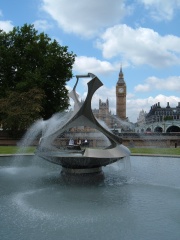
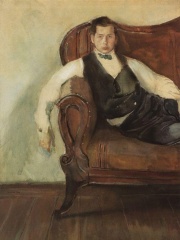
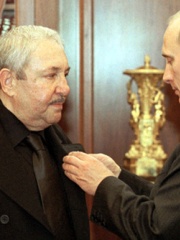
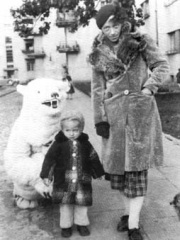
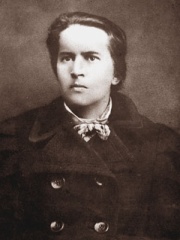
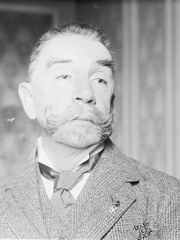

The Most Famous
SCULPTORS from Russia
This page contains a list of the greatest Russian Sculptors. The pantheon dataset contains 258 Sculptors, 8 of which were born in Russia. This makes Russia the birth place of the 8th most number of Sculptors behind United Kingdom, and Austria.
Top 8
The following people are considered by Pantheon to be the most legendary Russian Sculptors of all time. This list of famous Russian Sculptors is sorted by HPI (Historical Popularity Index), a metric that aggregates information on a biography's online popularity.

1. Naum Gabo (1890 - 1977)
With an HPI of 66.54, Naum Gabo is the most famous Russian Sculptor. His biography has been translated into 30 different languages on wikipedia.
Naum Gabo (born Naum Neemia Pevsner; Russian: Наум Борисович Певзнер; Hebrew: נחום נחמיה פבזנר) (5 August [O.S. 24 July] 1890 – 23 August 1977) was an influential sculptor, theorist, and key figure in Russia's post-Revolution avant-garde and the subsequent development of twentieth-century sculpture. His work combined geometric abstraction with a dynamic organization of form in small reliefs and constructions, monumental public sculpture and pioneering kinetic works that assimilated new materials such as nylon, wire, lucite and semi-transparent materials, glass and metal. Responding to the scientific and political revolutions of his age, Gabo led an eventful and peripatetic life, moving to Berlin, Paris, Oslo, Moscow, London, and finally the United States, and within the circles of the major avant-garde movements of the day, including Cubism, Futurism, Constructivism, the Bauhaus, de Stijl and the Abstraction-Création group. Two preoccupations, unique to Gabo, were his interest in representing negative space—"released from any closed volume" or mass—and time. He famously explored the former idea in his Linear Construction works (1942-1971)—used nylon filament to create voids or interior spaces as "concrete" as the elements of solid mass—and the latter in his pioneering work, Kinetic Sculpture (Standing Waves) (1920), often considered the first kinetic work of art. Gabo elaborated many of his ideas in the Constructivist Realistic Manifesto, which he issued with his brother, sculptor Antoine Pevsner as a handbill accompanying their 1920 open-air exhibition in Moscow. In it, he sought to move past Cubism and Futurism, renouncing what he saw as the static, decorative use of color, line, volume and solid mass in favor of a new element he called "the kinetic rhythms (…) the basic forms of our perception of real time." Gabo held a utopian belief in the power of sculpture—specifically abstract, Constructivist sculpture—to express human experience and spirituality in tune with modernity, social progress, and advances in science and technology. After working on a smaller scale in England during the war years (1936-1946), Gabo moved to the United States, where he received several public sculpture commissions, only some of which he completed. These include Constructie, a 25-metre (82 ft) commemorative monument in front of the Bijenkorf Department Store (1954, unveiled in 1957) in Rotterdam, and Revolving Torsion, a large fountain outside St Thomas' Hospital in London. The Tate Gallery, in Millbank, London, held a major retrospective of Gabo's work in 1966 and holds many key works in its collection, as do the Museum of Modern Art and Guggenheim Museum in New York. Work by Gabo is also included at Rockefeller Center in New York City and The Governor Nelson A. Rockefeller Empire State Plaza Art Collection in Albany, New York, US.

2. Konstantin Somov (1869 - 1939)
With an HPI of 61.18, Konstantin Somov is the 2nd most famous Russian Sculptor. His biography has been translated into 26 different languages.
Konstantin Andreyevich Somov (Russian: Константин Андреевич Сомов; 30 November [O.S. 18 November] 1869 – 6 May 1939) was a Russian artist associated with the Mir iskusstva ("World of Art") movement that began in the last decade of the 19th century. After the Russian Revolution, he eventually emigrated to Paris, along with other prominent figures in the Russian arts. In his private life, he had a longtime, younger male companion, Methodiy Lukyanov, and an ambiguous artistic and personal relationship with a young boxer, Boris Snezhkovsky, whom he painted many times. In the 21st century, his paintings have sold in the millions of dollars. In 2007, Somov's The Rainbow sold at Christie's London for GBP 3,716,000 (USD 7.44 million; equivalent to GBP 6.51 million [USD 13 million] in 2023), an auction record for a Russian work of art.

3. Ernst Neizvestny (1925 - 2016)
With an HPI of 58.41, Ernst Neizvestny is the 3rd most famous Russian Sculptor. His biography has been translated into 23 different languages.
Ernst Iosifovich Neizvestny (Russian: Эрнст Ио́сифович Неизве́стный; 9 April 1925 – 9 August 2016) was a Russian sculptor, painter, graphic artist, and art philosopher. He emigrated to the U.S. in 1976 and lived and worked in New York City. American playwright Arthur Miller once described Neizvestny as an "artist of the East" who is regarded by Russians as an "expression of the country, of its soul, language, and spirit" and as a "prophet of the future" who represents the "philosophical conscience of his country." Alexander Calder, the American artist, once said to Neizvestny, "All my life I create the world of children, and you create the world of man."

4. Katarzyna Kobro (1898 - 1951)
With an HPI of 57.25, Katarzyna Kobro is the 4th most famous Russian Sculptor. Her biography has been translated into 21 different languages.
Katarzyna Kobro (26 January 1898 – 21 February 1951) was a Polish avant-garde sculptor and a prominent representative of the Constructivist movement in Poland. A pioneer of innovative multi-dimensional abstract sculpture, she rejected Aestheticism and advocated for the integration of spatial rhythm and scientific advances into visual art. Born in Moscow to a family of mixed German and Russian heritage, Kobro immigrated to Poland in the 1920s where she produced most of her work. Together with her husband, Władysław Strzemiński, she worked on the concept of Spatiality by incorporating spatial composition as well as prefabricated elements and industrial or man-made products into sculpture.
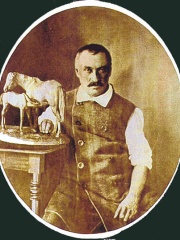
5. Peter Clodt von Jürgensburg (1805 - 1867)
With an HPI of 55.02, Peter Clodt von Jürgensburg is the 5th most famous Russian Sculptor. His biography has been translated into 15 different languages.
Peter Jakob Freiherr Clodt von Jürgensburg (Russian: Пётр Карлович Клодт, romanized: Pyotr Karlovich Klodt; 5 June 1805 – 25 November 1867) was a Russian sculptor. He was well regarded by Nicholas I of Russia.

6. Anna Golubkina (1864 - 1927)
With an HPI of 54.83, Anna Golubkina is the 6th most famous Russian Sculptor. Her biography has been translated into 21 different languages.
Anna Semyonovna Golubkina (Russian: Анна Семёновна Голубкина; January 28, 1864 – September 7, 1927) was a Russian impressionist sculptor. As the first Russian sculptor to receive the Paris Salon prize, she is regarded as the first female Russian sculptor of note. Golubkina also had an exhibition at the prestigious Alexander III Museum. A crater on Venus is named after her.

7. Walter W. Winans (1852 - 1920)
With an HPI of 51.98, Walter W. Winans is the 7th most famous Russian Sculptor. His biography has been translated into 16 different languages.
Walter W. Winans (April 5, 1852 – August 12, 1920) was an American marksman, horse breeder, sculptor, and painter who participated in the 1908 and 1912 Summer Olympics. He won two medals for shooting: a gold in 1908 and a silver in 1912, as well as demonstrating the sport of pistol duelling in the 1908 Games. He also won a gold medal for his sculpture An American Trotter at Stockholm in 1912. In addition, Winans wrote ten books.

8. Mikhail Anikushin (1917 - 1997)
With an HPI of 51.73, Mikhail Anikushin is the 8th most famous Russian Sculptor. His biography has been translated into 18 different languages.
Mikhail Konstantinovich Anikushin (Russian: Михаи́л Константи́нович Анику́шин; 19 September 1917, Moscow – 18 May 1997, Saint Petersburg) was a Soviet and Russian sculptor. Among his most famous works are a monument to Alexander Pushkin at Pushkinskaya Station of the Saint Petersburg Metro (1954), a monument to Alexander Pushkin at Arts Square in Saint Petersburg (1957), and a monument to Vladimir Lenin at Moskovskaya Square in Saint Petersburg. A minor planet 3358 Anikushin discovered by Soviet astronomer Nikolai Chernykh in 1978 is named after him.
People
Pantheon has 8 people classified as Russian sculptors born between 1805 and 1925. Of these 8, none of them are still alive today. The most famous deceased Russian sculptors include Naum Gabo, Konstantin Somov, and Ernst Neizvestny.
Deceased Russian Sculptors
Go to all RankingsNaum Gabo
1890 - 1977
HPI: 66.54
Konstantin Somov
1869 - 1939
HPI: 61.18
Ernst Neizvestny
1925 - 2016
HPI: 58.41
Katarzyna Kobro
1898 - 1951
HPI: 57.25
Peter Clodt von Jürgensburg
1805 - 1867
HPI: 55.02
Anna Golubkina
1864 - 1927
HPI: 54.83
Walter W. Winans
1852 - 1920
HPI: 51.98
Mikhail Anikushin
1917 - 1997
HPI: 51.73
Overlapping Lives
Which Sculptors were alive at the same time? This visualization shows the lifespans of the 7 most globally memorable Sculptors since 1700.

